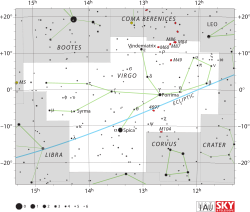Lambda Virginis
| Observation data Epoch J2000.0 Equinox J2000.0 |
|
|---|---|
| Constellation | Virgo |
| Right ascension | 14h 19m 06.59235s |
| Declination | −13° 22′ 15.9459″ |
| Apparent magnitude (V) | +4.52(5.00 + 5.63) |
| Characteristics | |
| Spectral type | A1 V(A1V + A1V) |
| U−B color index | +0.12 |
| B−V color index | +0.12 |
| Astrometry | |
| Radial velocity (Rv) | −10.9 km/s |
| Proper motion (μ) |
RA: −15.91 mas/yr Dec.: +28.92 mas/yr |
| Parallax (π) | 18.81 ± 0.10mas |
| Distance | 173.4 ± 0.9 ly (53.2 ± 0.3 pc) |
| Orbit | |
| Period (P) | 206.7321±0.0040 d |
| Semi-major axis (a) | 19.759±0.079 mas |
| Eccentricity (e) | 0.0610±0.0036 |
| Inclination (i) | 109.86±0.24° |
| Longitude of the node (Ω) | 196.40±0.22° |
| Periastron epoch (T) | 53,070.30±0.32 |
|
Argument of periastron (ω) (secondary) |
272.28±0.46° |
|
Semi-amplitude (K1) (primary) |
24.78±0.17 km/s |
|
Semi-amplitude (K2) (secondary) |
27.308±0.067 km/s |
| Details | |
| λ Vir A | |
| Mass | 1.897 M☉ |
| Radius | 2.35 R☉ |
| Luminosity | 20.84±0.25 L☉ |
| Surface gravity (log g) | 3.97 cgs |
| Temperature | 8,280±200 K |
| Metallicity [Fe/H] | 0.0097 dex |
| Rotational velocity (v sin i) | 36±1 km/s |
| Age | 935 Myr |
| λ Vir B | |
| Mass | 1.721 M☉ |
| Radius | 1.84 R☉ |
| Luminosity | 12.58±0.16 L☉ |
| Surface gravity (log g) | 4.14 cgs |
| Temperature | 8,280±200 K |
| Rotational velocity (v sin i) | 10±2 km/s |
| Other designations | |
| Database references | |
| SIMBAD | data |
Lambda Virginis (λ Vir, λ Virginis) is a binary star system in the zodiac constellation of Virgo. With an apparent visual magnitude of 4.5, it is bright enough to be seen with the naked eye. In China, 亢宿 (Kàng Xiù), meaning Neck, refers to an asterism consisting of this star, κ Virginis, ι Virginis and κ Virginis. Consequently, λ Virginis itself is known as 亢宿四 (Kàngsusì, English: the Fourth Star of Neck.)
Based upon parallax measurements, the Lambda Virginis system is about 173 light years away from the Sun. It is a double-lined spectroscopic binary with an orbital period of 206.7 days and an eccentricity of 0.0610. The semi-major axis has an angular size of 0.02″, which, at the distance of this system, is equivalent to a physical span of 1.050±0.007 AU. The orbit is inclined by an angle of 110° to the line of sight from the Earth. Tidal theory predicts that eventually the orbit of the stars will circularize and their rotation rates will become synchronized with their orbital motion. However, this will occur over a time scale of more than 1.2 billion years, whereas their estimated age is 935 million years.
...
Wikipedia

